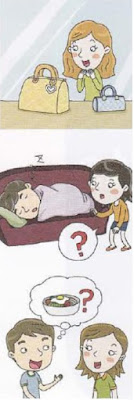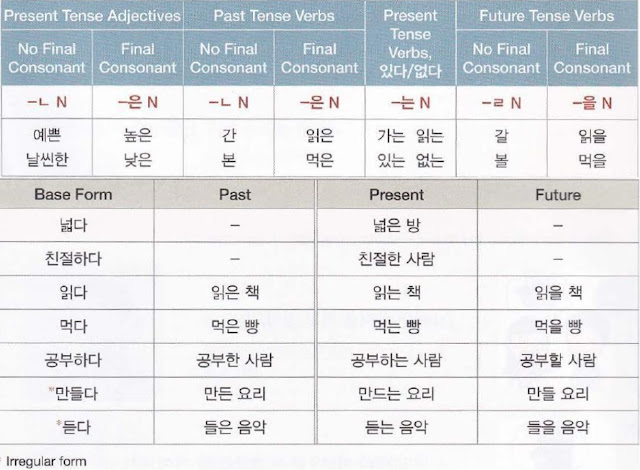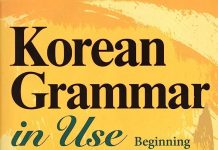 가방이 예뻐요. 그 가방을 사고 싶어요.
가방이 예뻐요. 그 가방을 사고 싶어요.
That purse is pretty. I want to buy that purse.
一> 예쁜 가방을 사고 싶어요.
I want to buy a pretty purse.
소파에서 사람이 자요. 그 사람이 누구예요?
There’s someone sleeping on the sofa. Who is that person?
一> 소파에서 자는 사람이 누구예요?
Who is that person (who is) sleeping on the sofa?
오늘 저녁에 한국 음식을 먹을 거예요. 그 음식이 뭐예요?
We’ll have a Korean dish for dinner today. What’s the dish?
一> 오늘 저녁에 먹을 한국 음식이 뭐예요?
What’s the Korean dish (that) we’ll have for dinner today?
Grammar Focus:
This pattern is added to verbs and adjectives to allow them to function as noun modifiers. The English equivalent is ‘that’ or ‘who’. For present-tense adjectives and past-tense verbs, -(으)ㄴ is added to the stem, for present-tense verbs, -는 is added, and for future-tense verbs, -(으)ㄹ is added. The negative forms are made by adding -지 않은 to the stem for adjectives, and -지 않는 to the stem for verbs.

A: 어떤 영화를 좋아해요?
What kind of movies do you like?
B: 재미있는 영화를 좋아해요.
I like funny movies.
A: 지금 커피를 마시는 사람이 누구예요?
Who is the person (who is) drinking coffee?
B: 제 친구예요.
My friend.
A: 어제 간 식당이 어땠어요?
How was the restaurant (that) you went to yesterday?
B: 친절한 서비스 때문에 기분이 좋았어요.
It was nice because of the good service.
A: 주말에 왜 못 만나요?
Why can’t you meet up during the weekend?
B: 할 일이 너무 많아서 못 만나요.
I have so many things (that I have) to do that I can’t meet up.
When two or more adjectives are used in succession, only the final adjective is conjugated to a noun modifier form.
• 착해요. 그리고 예뻐요. 그런 여자를 좋아해요.
(Someone who is) sincere. And pretty. I like that kind of girl.
->착한 예쁜 여자를 좋아해요. (X)
착하고 예쁜 여자를 좋아해요. (〇) I like a girl who is sincere and pretty.


![[Korean grammar] ‘ㅅ’ 불규칙 (Irregular Conjugation)](https://sayhikorean.com/wp-content/uploads/2021/10/112.1.jpg)
![[Korean grammar] ‘ㅎ’ 불규칙 (Irregular Conjugation)](https://sayhikorean.com/wp-content/uploads/2021/10/111.1.jpg)
![[Korean grammar] ‘르’ 불규칙 (Irregular Conjugation)](https://sayhikorean.com/wp-content/uploads/2021/10/110.1.jpg)
![[Korean grammar] ‘ㄷ’ 불규칙 (Irregular Conjugation)](https://sayhikorean.com/wp-content/uploads/2021/10/109.1.jpg)
![[Korean grammar] ‘ㅂ’ 불규칙 (Irregular Conjugation)](https://sayhikorean.com/wp-content/uploads/2021/10/108.1.jpg)
![[Korean grammar] ‘ㄹ’ 불규칙 (Irregular Conjugation)](https://sayhikorean.com/wp-content/uploads/2021/10/107.1.jpg)
![[Korean grammar] ‘ㅡ’ 불규칙 (Irregular Conjugation)](https://sayhikorean.com/wp-content/uploads/2021/10/106.1.jpg)
![[Korean grammar] Indirect Quotation Contracted Forms: -대요, -래요, -재요, -냬요](https://sayhikorean.com/wp-content/uploads/2021/10/105.1.jpg)
![[Korean grammar] Indirect Quotations](https://sayhikorean.com/wp-content/uploads/2021/10/104.1.jpg)
![[Korean grammar] Direct Quotations: ‘Quoted speech’ + 하고/라고 + V](https://sayhikorean.com/wp-content/uploads/2021/10/103.1.jpg)
![[Korean grammar] A/V-(으)ㄴ/는데요 Additional Endings](https://sayhikorean.com/wp-content/uploads/2021/10/102.1.jpg)
hi.. its on korean grammar in use beginner ? if yes 몇과에요?